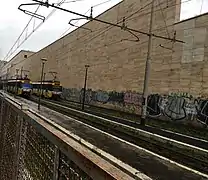Roma Laziali Termini Laziali | |
|---|---|
| Train station | |
 View of the station in 1979 | |
| General information | |
| Location | Via Giovanni Giolitti, Rome Italy |
| Owned by | ATAC |
| Operated by | ATAC |
| Line(s) | Rome-Giardinetti railway |
| Tracks | 3 |
| Connections | Rome Termini railway station |
| History | |
| Opened | 1950 |
Roma Laziali is a railway station in Rome located next to the southern façade of Termini station. It is the western terminus of the Rome-Giardinetti railway.[1][2][3]
History
In 1905 the suburban tramway operator STEFER inaugurated their northern terminus on the square in front of Termini station. STEFER connected the southeastern suburbs with Rome. In 1916 the tramstation was expanded in order to serve the SFV suburban tramway to the east. Until the twenties of the twentieth century the suburban tramways transported passengers and freight. The freight services should run towards San Lorenzo goods station, but without a direct track from the SFV line the freight services had to proceed to the terminus, shunt the locomotive and drive in the opposite direction back to San Lorenzo. This was solved with a direct track between the SFV-line and the goods station. In 1935 the gouvernor of Rome proposed a world's fair for the year 1942. In 1937 it was decided to build a new modern railway station to welcome the expected visitors as well an underground to transport this visitors between the station and the world's fair. The building of the underground station forced the tramways to leave the square and closing the tramlines was considered. In 1940 a new terminus for the tramways was opened in the Via Giolitti at the crossing with the Via Gioberti. The world's fair was canceled and the opening of the new Termini station was postponed to after World War II. At the time the new station building was opened on 20 December 1950, the terminus of the suburban tramways was relocated to the southern entrance of the new station, opposite the milk plant on the Via Mamiani, approximately 400 metres south of the original terminus.[4]
 A suburban tram near the station around 1951
A suburban tram near the station around 1951 Arrival of a STEFER tram on 1 January 1979
Arrival of a STEFER tram on 1 January 1979 The station in April 2020
The station in April 2020
Operations
The suburban trams used 5 tracks until 1983 when the number of tracks was reduced to 3. The two tracks next to the façade of Termini station were split in two sections with a crossover in between. These tracks were used by the SFV services to Fiuggi. The other tracks were used by the STEFER services to the southeast. STEFER's suburban tramway was replaced by underground line A on 16 February 1980. In 1983 Roma Laziali station was narrowed to 3 tracks and the Via Giolotti was improved in favour of road traffic. In 1986 the SFV was integrated in Rome's public transport after the line east of Monte Compatri-Pantano had been damaged during heavy weather and repair was ruled out. The suburban tramservice continued until 20 July 1996 when the improvement works began east of Grotte Celoni. On 26 August 1999 the line was curtailed to Giardinetti with the beginning of the improvement works outside the Grande Raccordo Anulare (GRA). As a result, the name of the line was changed in Rome–Giardinetti railway. The suburban services resumed as premetro outside the GRA on 2 October 2005. On 7 July 2008 the premetro was closed for the conversion to a real underground line. The eastern part of underground line C was opened on 9 November 2014 and on 29 June 2015 line C between Parco di Centocelle and the city centre entered service. The suburban tramservice along the via Casilina was curtailed to Centocelle on 3 August 2015, although it retained the name Roma-Giardinetti.
Services
 Automatic Ticket Machine
Automatic Ticket Machine
Interchanges
 Rome Termini railway station
Rome Termini railway station Bus stop
Bus stop
References
- ↑ "Il Campidoglio punta sul "trenino giallo": 100 milioni per il prolungamento da Centocelle a Tor Vergata". RomaToday. Retrieved 2018-07-19.
- ↑ "Un futuro per la Roma-Giardinetti - Comitato Metro X Roma". Comitato Metro X Roma (in Italian). 2017-03-28. Retrieved 2018-07-19.
- ↑ "Odissea Quotidiana: Roma-Giardinetti: quale futuro?". Odissea Quotidiana. Retrieved 2018-07-19.
- ↑ Giglio, Giovanni. "La Storia". web.tiscalinet.it. Retrieved 2018-07-20.